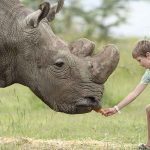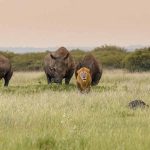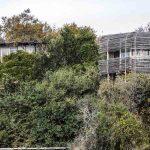A pack of three Rhinoceroses from the Czech Republic arrived in Tanzania last weekend and were sent to the Mkomazi Rhino sanctuary in Kilimanjaro region.
The Black Rhinos of Diceros Bicornis Michaeli species landed at the Kilimanjaro International Airport from Amsterdam aboard a large customized cargo craft, Boeing 747-400 BCF belonging to the Martinair Airline. They rode in three huge wooden crates.
“The rhino were crate-trained for two months to prepare them for the long flight inside the cages, it required a high level of skilled training to ensure that the animals rode comfortably,” stated the retired Brigadier General Hashim Mbita the chairman of the Wildlife Trust Fund.
The animals were taken from the Dvur Kralove zoo, Czech Republic. The Zoo, which specializes in Africa fauna, is reported to be one of the most successful captive-breeding programmes for the Black Rhino in the world. Their rarest animal is the Northern white rhino.
The translocation of the three black ‘Michael’ Rhinos from Czech Republic cost over US $70,000 this was made possible through a fund-raiser previously done by the Suzuki Rhino Club of Netherlands. Ted and Catrina van Dam who head the Suzuki Rhino club have also been supporting the Mkomazi Rhino project.
Two decades ago, Tanzania, with the help of other African Parks, governments, and conservationists, including the George Adamson Wildlife Trust had hatched a protected breeding program to boost the black rhino numbers in parks. They started the Mkomazi Rhino Sanctuary, occupying 43 square miles of the total 2,200 square miles of the new Mkomazi National Park in Same District, Kilimanjaro region. The sanctuary is protected by 24-hours patrol guards and an electrified, alarmed fence.
“At Mkomazi the newly brought Rhinos will be kept under special care and monitoring within the sanctuary before being released into the wild,” explained the Director General for the Tanzania National Parks, Mr. Gerald Bigurube, adding that the animals must first learn to adopt to the local environment before being let out.
Which is just as well because, the first rhino refused to leave its crate, upon being let out at Mkomazi and it took a full hour of team effort to persuade the animal to enter the sanctuary.
Tanzania however shouldn’t entirely feel like a new planet to the three newly received black rhinos because according to the Director General of TANAPA, the animals were among those taken from East Africa in the early sixties and sent to the Czech’s zoo for their safety when their survivals here could not be guaranteed.
Ms Halima Mangi an Ecologist at Mkomazi said the new batch from Czech now brings up the total number of Rhinoceroses at Mkomazi National Park to Nine. “Rhinos had totally disappeared here in the 80s therefore this project, aimed at restoring the species, was started,” she said.
The first four rhinos brought from South Africa, two males and two females were introduced to the sanctuary in 1997 with the second batch of four following in 2001. They started to reproduce in 2005 and by 2008 four new babies had been born, however two of these young ones and an older Rhino later died.
The priority at Mkomazi, according to Tony Fitzjohn the Field Director of George Adamson Wildlife Preservation Trust, is to increase the founder population to at least 15 rhinos from which a whole new population can be created. Dr Dana Holeckova, the Director of the Dvur Kralove Zoo had previously visited Mkomazi with Dr Hamish Currie of Back to Africa and agreed to donate 3 black rhino of Diceros bicornis michaeli species to its Rhino sanctuary.
Dr Peter Morkel, Berry White and Dvur Kralove rhino keepers played an important role in ensuring smooth and safe translocation of Rhinos while back here Tony Fitzjohn, Elisaria Nnko, Wilfred Ayo, Semu Pallangyo and Philbert Shindano handled all the necessary responsibilities.
Ground transportation was taken care of by Grumeti Reserves, Frankfurt Zoological Society, Save-the-Rhino society and again the Suzuki Rhino Club. Support also came from A & K.






